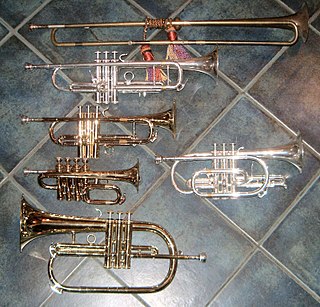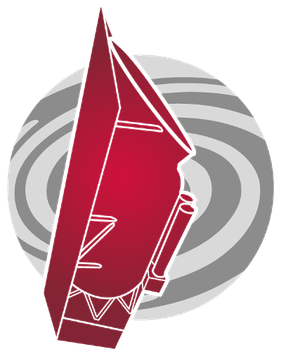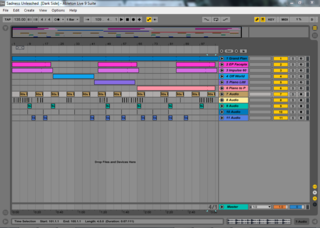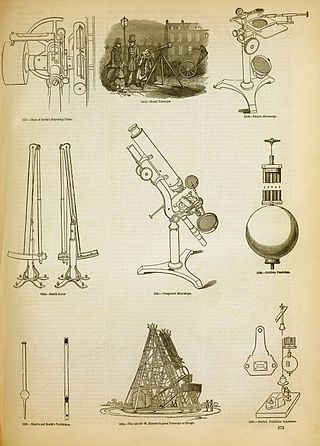A viewing instrument is a type of optical instrument that is used to assist viewing or visually examining an object or scenery.
A viewing instrument is a type of optical instrument that is used to assist viewing or visually examining an object or scenery.

A brass instrument is a musical instrument that produces sound by sympathetic vibration of air in a tubular resonator in sympathy with the vibration of the player's lips. Brass instruments are also called labrosones or labrophones, from Latin and Greek elements meaning 'lip' and 'sound'.

In aviation, instrument flight rules (IFR) is one of two sets of regulations governing all aspects of civil aviation aircraft operations; the other is visual flight rules (VFR).

A sextant is a doubly reflecting navigation instrument that measures the angular distance between two visible objects. The primary use of a sextant is to measure the angle between an astronomical object and the horizon for the purposes of celestial navigation.

A reflecting telescope is a telescope that uses a single or a combination of curved mirrors that reflect light and form an image. The reflecting telescope was invented in the 17th century by Isaac Newton as an alternative to the refracting telescope which, at that time, was a design that suffered from severe chromatic aberration. Although reflecting telescopes produce other types of optical aberrations, it is a design that allows for very large diameter objectives. Almost all of the major telescopes used in astronomy research are reflectors. Many variant forms are in use and some employ extra optical elements to improve image quality or place the image in a mechanically advantageous position. Since reflecting telescopes use mirrors, the design is sometimes referred to as a catoptric telescope.

The field of view (FOV) is the angular extent of the observable world that is seen at any given moment. In the case of optical instruments or sensors, it is a solid angle through which a detector is sensitive to electromagnetic radiation. It is further relevant in photography.

The Infrared Space Observatory (ISO) was a space telescope for infrared light designed and operated by the European Space Agency (ESA), in cooperation with ISAS and NASA. The ISO was designed to study infrared light at wavelengths of 2.5 to 240 micrometres and operated from 1995 to 1998.

Laboratory Virtual Instrument Engineering Workbench (LabVIEW) is a graphical system design and developmentplatform produced and distributed by National Instruments, based on a programming environment that uses a visual programming language. It is widely used for data acquisition, instrument control, and industrial automation. It provides tools for designing and deploying complex test and measurement systems.

National Instruments Corporation, doing business as NI, is an American multinational company with international operation. Headquartered in Austin, Texas, it is a producer of automated test equipment and virtual instrumentation software. Common applications include data acquisition, instrument control and machine vision. Since October 2023, NI operates as Emerson Electric's test and measurement business unit after getting acquired.

Ableton Live, also known as Live or sometimes colloquially as "Ableton", is a digital audio workstation for macOS and Windows developed by the German company Ableton.

Ophthalmoscopy, also called funduscopy, is a test that allows a health professional to see inside the fundus of the eye and other structures using an ophthalmoscope. It is done as part of an eye examination and may be done as part of a routine physical examination. It is crucial in determining the health of the retina, optic disc, and vitreous humor.

An optical instrument is a device that processes light waves, either to enhance an image for viewing or to analyze and determine their characteristic properties. Common examples include periscopes, microscopes, telescopes, and cameras.
An arpeggio is a type of broken chord in which the notes that compose a chord are individually sounded in a progressive rising or descending order. Arpeggios on keyboard instruments may be called rolled chords.

A sight or sighting device is any device used to assist in precise visual alignment of weapons, surveying instruments, aircraft equipment, optical illumination equipment or larger optical instruments with the intended target. Sights can be a simple set or system of physical markers that serve as visual references for directly aligning the user's line of sight with the target, or optical instruments that provide an optically enhanced—often magnified—target image aligned in the same focus with an aiming point. There are also sights that actively project an illuminated point of aim onto the target itself so it can be observed by anyone with a direct view, such as laser sights and infrared illuminators on some night vision devices, as well as augmented or even virtual reality-enabled digital cameras with software algorithms that produce digitally enhanced target images.

The bandurria is a plucked chordophone from Spain, similar to the mandolin and bandola, primarily used in Spanish folk music, but also found in former Spanish colonies.

The octant, also called a reflecting quadrant, is a reflecting instrument used in navigation.

Jantar Mantar is located in the modern city of New Delhi. "Jantar Mantar" means "instruments for measuring the harmony of the heavens". It consists of 13 architectural astronomy instruments. The site is one of five built by Maharaja Jai Singh II of Jaipur, from 1723 onwards, revising the calendar and astronomical tables. Jai Singh, born in 1688 into a royal Rajput family that ruled the regional kingdom, was born into an era of education that maintained a keen interest in astronomy. There is a plaque fixed on one of the structures in the Jantar Mantar observatory in New Delhi that was placed there in 1910 mistakenly dating the construction of the complex to the year 1710. Later research, though, suggests 1724 as the actual year of construction. Its height is 723 feet (220 m).

Hinode, formerly Solar-B, is a Japan Aerospace Exploration Agency Solar mission with United States and United Kingdom collaboration. It is the follow-up to the Yohkoh (Solar-A) mission and it was launched on the final flight of the M-V rocket from Uchinoura Space Center, Japan on 22 September 2006 at 21:36 UTC. Initial orbit was perigee height 280 km, apogee height 686 km, inclination 98.3 degrees. Then the satellite maneuvered to the quasi-circular Sun-synchronous orbit over the day/night terminator, which allows near-continuous observation of the Sun. On 28 October 2006, the probe's instruments captured their first images.
The following tables provide a comparison of numerical analysis software.

The Wide Field Camera 3 (WFC3) is the Hubble Space Telescope's last and most technologically advanced instrument to take images in the visible spectrum. It was installed as a replacement for the Wide Field and Planetary Camera 2 during the first spacewalk of Space Shuttle mission STS-125 on May 14, 2009.

The International Astrophysical Observatory "GRANAT", was a Soviet space observatory developed in collaboration with France, Denmark and Bulgaria. It was launched on 1 December 1989 aboard a Proton rocket and placed in a highly eccentric four-day orbit, of which three were devoted to observations. It operated for almost nine years.